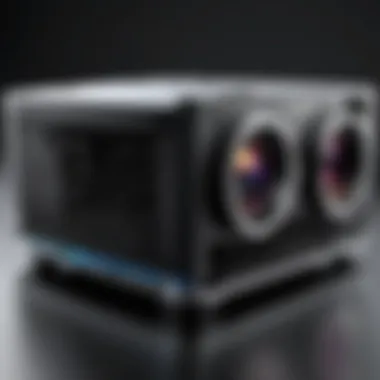Exploring 3D Projector Pricing Dynamics


Intro
In the realm of visual technology, 3D projectors have carved a unique niche. Their pricing dynamics reflect a convergence of numerous factors, from technical specifications to market trends. Understanding these pricing structures can empower consumers, particularly IT professionals and tech enthusiasts, to navigate choices effectively.
Features Overview
Gaining insights into the features of 3D projectors is the first step towards understanding their market value. Prices can vary significantly based on technical attributes and unique selling points.
Key Specifications
3D projectors come with a multitude of specifications that determine their performance and price. Key aspects include:
- Brightness: Measured in lumens, higher brightness yields better visibility in varied lighting.
- Resolution: The clarity of the image produced greatly influences pricing. Common resolutions are 1080p and 4K.
- 3D Technology: Different methods, such as DLP or LCD, can impact price. DLP generally offers better color depth and contrast.
- Connectivity Options: HDMI, USB, and wireless capabilities can sway price points depending on user needs.
Each specification has a role in shaping the overall cost. Consumers need to analyze their specific requirements to correlate these specs with corresponding price ranges.
Unique Selling Points
Some brands differentiate themselves through unique features. These selling points often justify higher prices:
- Advanced Color Technology: Some projectors employ enhanced color technologies for more vivid images.
- Long Lamp Life: Projectors that offer extended lamp longevity may come with a higher price tag due to lower maintenance costs.
- Smart Features: Integration with streaming services or mobile apps can also elevate pricing, appealing to those seeking convenience.
"Investing in a quality 3D projector isn’t just about upfront cost; it involves considering long-term value and functionality."
Performance Analysis
Performance is a crucial factor influencing pricing. Beyond specifications, performance in both benchmark tests and real-world settings provides clear insights.
Benchmarking Results
Several independent tests evaluate 3D projectors based on:
- Image Quality: This includes factors like brightness uniformity and color accuracy.
- Latency: For gamers, input lag is a key performance metric that must be considered.
- Noise Levels: The operational sound can affect usage experience, particularly in quiet environments.
Real-world Scenarios
Exploring the performance of 3D projectors in practical situations reveals their true value. Retail environments might highlight:
- Home Theater Use: The ambiance and setup can enhance or detract from performance, affecting overall satisfaction and perceived value.
- Corporate Settings: Brightness and clarity in professional presentations can determine the utility of the projector, influencing choice and investment.
In both scenarios, understanding how a projector performs under actual usage conditions is vital for budgeting and purchasing decisions.
End
The landscape of 3D projectors encompasses a variety of features and performance metrics that directly correlate to their pricing. By dissecting these elements, IT professionals and tech enthusiasts can align their purchasing decisions with the intrinsic value offered by different models. This comprehensive understanding fosters informed choices in a complex market.
Prologue to 3D Projectors
Understanding 3D projectors is essential for both consumers and IT professionals who want to make informed decisions in a rapidly evolving tech landscape. These devices elevate the viewing experience, providing a dimensionality that is ideal for movies, gaming, and professional presentations. With increasing adoption in homes and businesses, the market dynamics are complex and influenced by various factors.
3D projectors do not merely enhance visual experiences; they impact how information is consumed and shared across different contexts. Whether it's for entertainment, educational purposes, or corporate settings, 3D projection technology opens new avenues of engagement. The relevance of this technology has gained momentum amid persistent advancements in digital displays and graphics.
Defining 3D Projectors
3D projectors are devices capable of displaying images in three dimensions, enhancing visual perception for the viewer. Unlike traditional projectors that present a flat image, 3D projectors utilize specific technologies, such as active or passive shutter systems, to create the illusion of depth. They are generally categorized based on the methods they employ: some use polarization, while others rely on active glasses to synchronize with the projector’s output.


It's paramount for users to comprehend the specifications and mechanisms behind 3D projectors as they directly affect performance and usability. Features like brightness, resolution, and color accuracy contribute significantly to the viewing experience. Also, the technology behind the device affects pricing, durability, and overall operational efficiency.
Applications of 3D Projection Technology
The applications of 3D projection technology are diverse, serving numerous fields and industries. In entertainment, these projectors have redefined cinema experiences, enabling audiences to immerse themselves in a world where depth enhances storytelling. Not only do they create engaging visuals in movie theaters, but they are also used in home theaters, expanding options for entertainment lovers.
In education, 3D projectors contribute to more dynamic and interactive teaching methods. They help visualize complex concepts in subjects like science and mathematics, making learning more accessible and appealing. Furthermore, professional environments make use of this technology during presentations and training sessions, adding an interactive layer that can facilitate understanding and retention.
Overall, understanding both the definition and applications of 3D projectors is crucial for making sound purchasing choices and leveraging this technology for various purposes.
Factors Influencing 3D Projector Prices
Technology and Features
When assessing the price of a 3D projector, technology and features play a vital role. The advancement of display technologies such as DLP (Digital Light Processing) and LCoS (Liquid Crystal on Silicon) impacts the quality of projection significantly. Higher-end models often incorporate superior optics, resulting in better color accuracy, brightness, and contrast. Additionally, features such as 4K resolution and advanced connectivity options, including HDMI and wireless capabilities, enhance user experience but also increase manufacturing costs.
Incorporating cutting-edge features can elevate the projector's pricing, with customers willing to pay more for enhanced performance and reliability. Therefore, understanding the technical aspects and their respective costs can explain variances in product pricing.
Brand Reputation
Brand reputation plays an essential part in the pricing structure of 3D projectors. Established brands such as Epson, Sony, and BenQ command higher prices due to their long-standing market presence and perceived reliability. Consumers often associate these brands with superior quality, which justifies the premium pricing.
Newer or lesser-known brands may offer similar technology at lower prices, but they often lack the same level of consumer trust. The reputation not only affects initial investment but also influences resale value and customer satisfaction. Each brand's history with customer service and warranty provisions also contributes to their overall value perception, impacting prices significantly.
Market Demand and Supply
Market demand and supply dynamics fundamentally affect the pricing of 3D projectors. During periods of high demand, prices can rise, reflecting the competition among consumers for limited supplies. Factors such as new product releases or seasonal trends can lead to fluctuations in demand. Additionally, economic conditions and technological advances can shift consumer preferences, influencing pricing structures.
Conversely, when supply exceeds demand, manufacturers may lower prices to move inventory. This can create opportunities for consumers to acquire high-quality products at reduced rates. Monitoring these market trends helps both consumers and industry players make informed decisions, navigating the complexities of 3D projector acquisitions effectively.
"Awareness of the factors influencing pricing can empower consumers to make informed decisions when purchasing 3D projectors."
In summary, each of these factors plays a crucial role in determining the pricing of 3D projectors. Understanding the relationship between technology, brand reputation, and market dynamics can lead to more strategic purchasing decisions based on actual needs rather than impulse.
Comparative Pricing Analysis
The Comparative Pricing Analysis of 3D projectors serves as a crucial aspect of this article as it enables consumers to understand the distinctions in pricing that exist across different models and brands. This section provides an analytical framework that illuminates how various factors play into the pricing strategies utilized by manufacturers. By examining comparative pricing, potential buyers can make more informed decisions tailored to their individual needs or organizational budgets. This analysis not only assesses performance and features but also examines overall value, helping consumers to discern which models offer the best return on their investment.
High-End vs. Budget Models
When it comes to 3D projectors, there is a clear divide between high-end and budget models. High-end models often feature advanced technology and superior performance capabilities. For example, prominent brands like Sony and JVC produce models that boast exceptional resolution and brightness levels. These projectors are ideal for professional environments or high-performance home theaters. The initial purchase price of these projectors can be significantly higher, sometimes exceeding several thousand dollars.
In contrast, budget models from brands such as Epson and BenQ cater to consumers looking for an acceptable performance at a lower price point. These projectors usually range from $500 to $1,500. While they may have lower resolution and brightness, for many users, especially casual viewers, the performance may be more than adequate. It is important to evaluate what you need from a projector before proceeding:
- Use Case: If it is professional work, high-end might be necessary.
- Budget Limitations: Always consider your budget carefully.
- Advanced Features: Do you require features like high brightness or superior contrast?
Regional Pricing Variations
Regional pricing variations can significantly influence the cost of 3D projectors. Different geographical areas have diverse economic conditions and market demands, leading to price discrepancies. For instance, a 3D projector that costs $1,000 in the United States might be notably cheaper or more expensive in Europe or Asia due to import taxes, shipping fees, and local market conditions.
Understanding these regional pricing variations is essential for international buyers or those considering importing a model from abroad. In some cases, purchasing a projector locally can provide added benefits:
- Warranty Services: Local purchases often come with better warranty services.
- Availability of Support: Local vendors often provide better customer service.
- After-Sales Services: Accessibility to local repairs can be easier.
Thus, when making a decision, potential buyers need to consider both the costs involved and the practicalities of purchasing across borders.


"Knowing the market variations can prevent overpaying for a projector not just based on features but also geography."
This analysis empowers consumers by providing a nuanced understanding of what different models offer against their respective price points, as well as the broader market forces at play.
Cost-Effectiveness of 3D Projectors
Understanding the cost-effectiveness of 3D projectors is essential for consumers who want to make a well-informed purchase. This section covers the total cost of ownership, which considers not only the purchase price but also ongoing expenses. Additionally, we will explore the return on investment (ROI) to understand how these devices can contribute to monetary gain, especially in professional environments.
Total Cost of Ownership
Initial Purchase Price
The initial purchase price of a 3D projector is often where buyers begin their evaluation. This cost can vary significantly based on brand and features. High-end models from brands like Epson or Sony may come with a higher price tag due to advanced technology and capabilities. In contrast, budget-friendly options from lesser-known brands may be more appealing but often come with reduced performance.
The key aspect of the initial purchase price is its influence on overall spending. A more expensive projector might seem daunting, but it could offer superior features that enhance the viewing experience. Choosing a projector involves weighing the need for quality against the upfront cost.
Advantages of a higher initial outlay include better image clarity, advanced connectivity options, and longer lifespans. However, lower-priced projectors can save money upfront but might incur higher costs later due to poor performance or limited features.
Maintenance and Repair Costs
Maintenance and repair costs are another important element of total cost of ownership. Like any technology, 3D projectors require upkeep to function effectively over time. Regular maintenance includes cleaning filters, managing lamp life, and ensuring that software is updated.
Higher-end projectors typically have a longer warranty period and allow for easier service, reducing unexpected repair costs.
Choosing a 3D projector that is easier to maintain can lead to significant savings. However, neglecting maintenance can lead to costly repairs or replacements in the long run.
Replacement Parts
The availability and cost of replacement parts also contribute to the overall financial picture. Many projectors require replacement bulbs, lenses, or filters, which can add up over time. Brands that provide easy access to these parts can save users time and money.
For instance, some models require specific parts that may only be available through authorized dealers, increasing costs.
A projector that is cheaper initially but has high replacement part prices could ultimately be more expensive than a slightly pricier model with more reasonable replacement costs.
Return on Investment (ROI)
Usage Scenarios
$$
Usage scenarios play an important role in determining the ROI of a 3D projector. In educational settings or for businesses, the projector can be a critical tool for presentations and training. The ability to display engaging 3D visuals can enhance understanding and retention among audiences.
For personal use, a projector may serve entertainment purposes, making it a valuable addition to home theaters. The higher the frequency of use, the more justifiable the cost becomes.
Potential Revenue Generation
Potential revenue generation is where the ROI of 3D projectors can really shine, especially in business environments. Companies that use 3D projectors for client presentations or internal training can expect to see a return in increased engagement and accelerated decision-making processes.
Furthermore, industries like medicine and architecture may rely on 3D projectors to convey complex information visually; this investment can lead to higher client satisfaction and more contracts.
Consequently, understanding how the projector fits into business operations becomes crucial when considering purchase options.
Buying Guides for 3D Projectors
Buying a 3D projector can be complex due to the variety of options available. The buying guide serves as a crucial tool for consumers to navigate this market. It distills essential information that ensures a well-informed purchasing decision. Focused knowledge on key specifications and where to buy can significantly impact user satisfaction and usability.
A good guide helps potential buyers identify crucial specifications that meet their needs and budgets. This enhances the value obtained from their investment. Moreover, understanding where to purchase affects pricing and reliability. Thus, having a solid buying guide is fundamental for anyone looking to invest in a 3D projector.
Key Specifications to Consider
Resolution
Resolution refers to the number of pixels that make up the projector's image. The higher the resolution, the sharper and more defined the visuals. In this context, higher resolutions like 4K are becoming increasingly popular as they deliver breathtaking clarity. Many users prefer 4K resolution due to the level of detail it provides, which is particularly advantageous for cinematic experiences.
However, there are disadvantages to consider. Higher resolution projectors tend to come with a higher price tag. Therefore, buyers need to assess whether the premium cost aligns with their viewing needs and preferences.
Brightness
Brightness, measured in lumens, determines how well a projector performs in different lighting conditions. This feature is particularly important for environments that are not fully dark. A higher brightness rating means clearer images in ambient light. Many users opt for projectors with brightness over 3000 lumens for better versatility in various settings.
On the downside, projectors with high brightness can often be more expensive. It's essential for buyers to think about the typical viewing environment and adjust their brightness preference accordingly.
Contrast Ratio


Contrast ratio describes the difference between the darkest and lightest parts of an image. A higher contrast ratio leads to richer colors and depth in images. This is vital for both home cinema and professional presentations. Some projectors boast a contrast ratio of 100,000:1 or more, which many users find appealing for enhanced viewing experiences.
Nonetheless, a higher contrast capability might also come with elevated costs. It’s crucial for buyers to balance their desire for quality with their budget capacity to ensure satisfaction.
Where to Purchase
Retail vs. Online
Purchasing 3D projectors can happen in either retail stores or online platforms. Each has its own set of benefits. Retail stores allow for immediate purchase and the ability to physically examine the projector before buying. However, prices might be higher in brick-and-mortar settings due to operational costs.
On the other hand, online shopping often offers a wider selection. Many users find better deals and discounts through e-commerce platforms. However, the inability to physically inspect the product can be a drawback. Awareness of the return policy is crucial if going this route.
Warranty Considerations
Warranties are critical when purchasing a 3D projector. A good warranty can protect your investment, providing peace of mind in case of defects or issues. Many projectors come with warranties ranging from one to three years. Buyers should pay attention to the terms and conditions included.
A unique feature of warranties is their role in consumer trust. A longer warranty adds credibility to a brand. However, warranty coverage can vary greatly among brands, impacting the perception of their reliability. Thus, evaluating warranty options is an important aspect of the buying process.
Future Trends in 3D Projection Technology
The world of 3D projection technology is continually evolving. Understanding future trends in this domain is critical for both consumers and professionals. These trends not only shape the upcoming devices but also impact pricing strategies. By keeping an eye on these advancements, one can make well-informed decisions about purchasing and investing in 3D projectors.
Emerging Technologies
Emerging technologies play a significant role in the development of 3D projectors. Key innovations include:
- Laser Projection: Unlike traditional lamp-based projectors, laser projectors provide better brightness and longer lifespan. This technology leads to lower maintenance costs, which can influence purchase decisions as well.
- 4K Resolution: As consumers demand higher resolution, 4K projectors are becoming more common. This increase in pixel density enhances the viewing experience and allows for larger screen sizes without quality degradation.
- Advanced Image Processing: Technologies like HDR (High Dynamic Range) improve color depth and contrast. Enhanced processing capabilities mean projectors can better manage varying brightness levels, creating a more captivating presentation.
These technologies collectively influence the pricing dynamics of 3D projectors. For instance, laser and 4K projectors typically command higher prices due to their advanced features. Consumers must assess whether the benefits justify the expenditure.
Market Predictions
Looking ahead, market predictions indicate several possibilities. Analysts forecast growth in both consumer and professional markets. Key factors influencing this growth include:
- Increased Adoption in Education and Business: As more institutions integrate advanced technologies, demand for efficient 3D projectors in classrooms and boardrooms will rise.
- Home Cinema Growth: With the rise of home entertainment systems, more consumers are inclined to invest in quality projection systems for personal use.
- Sustainability Concerns: As environmentally-friendly technologies gain prominence, devices that promise lower energy consumption will attract attention.
Overall, these market predictions suggest a diverse range of options for potential buyers, leading to varied pricing strategies.
"The next few years are crucial for 3D projection technology, as innovation meets consumer demand in ways we have yet to fully understand."
Understanding these trends equips potential buyers and tech enthusiasts to navigate a complex market. Staying informed about technology and market shifts is essential for making savvy purchases and investment decisions.
Finale
In this section, we revisit essential elements discussed in the previous sections. We look at the interplay of technological advancements and market dynamics that shape the pricing of 3D projectors. Understanding this relationship is crucial for making informed decisions when purchasing.
3D projectors are impacted by numerous factors such as brand reputation, features, and market demand. As technology evolves, so does the pricing structure of these devices. Higher-end models with advanced features come at a premium, while budget models aim to attract cost-conscious consumers. Analyzing these variables allows potential buyers to assess what suits their needs best.
"The landscape of 3D projectors continues to evolve, and staying informed is key to navigating pricing effectively."
Summarizing Key Points
To recap, several key points emerge from our analysis:
- Technology and Features: Projectors with higher specifications tend to command higher prices. Understanding what features matter most can help consumers prioritize their purchases.
- Brand Reputation: Not all brands are equal. Established brands like Epson and Sony may offer more reliability but at higher costs.
- Market Demand and Supply: Fluctuations in the market can lead to varying prices. Seasonal trends often see prices rise or fall based on consumer interest.
- Cost-Effectiveness: Evaluating total costs, including maintenance and potential revenue generation, is essential for determining true value.
Final Recommendations
When considering the purchase of a 3D projector, take these factors into account:
- Identify Usage Scenarios: Understand what you need the projector for, be it home theater usage or professional presentations. This can influence the specifications you prioritize.
- Evaluate Long-term Costs: Beyond the initial purchase price, consider ongoing costs such as maintenance and potential upgrade paths.
- Research Market Trends: Keep an eye on emerging technologies and market shifts. As seen with past trends, prices can change rapidly based on innovation and consumer interest.
- Consult Expert Reviews: Look for reviews from credible sources to understand a product's performance and value before making a decision.
In summary, the intricate pricing dynamics of 3D projectors require careful thought and analysis. By synthesizing the knowledge gained from this article, readers can approach the market equipped with a nuanced understanding, paving the way for more strategic purchasing decisions.



